Effects of Corner Constraint on the Microstructure and Mechanical Properties of Aluminum Alloy Using the CMT+P Deposition Process
Abstract
:1. Introduction
2. Experimental Materials and Methods
3. Results and Discussion
3.1. Comparison of Microstructure between Corner-Constrained and Unconstrained Zones
3.1.1. Macro Morphology
3.1.2. Microstructure
3.1.3. Distribution of Alloying Elements
3.2. Comparison of Mechanical Properties between Corner-Constrained and Unconstrained Zones
3.2.1. Microhardness
3.2.2. Tensile Test
3.2.3. Fracture Analysis
4. Conclusions
- Using the CMT+P process in this study, we could wire arc additive preparation of 4043 aluminum alloy. The UZ and CCZ do not appear to have melt pool flow, cracking, porosity, inclusions, and other welding defects, resulting in good bonding between the deposited layers.
- There are fine and uniform α-Al and Al–Si eutectic structures inside the 4043 aluminum alloy, and the Si is biased and concentrated mainly in the grain boundary region. The Si content of the CCZ is between 5% and 10%, and the Si content of the UZ is between 5% and 30%. There are equiaxed crystals in the UZ, while there are no equiaxed crystals in the CCZ. The grain size of α-Al increases with the increase in reheating times (RHs), and the grain size increases by about 10% with each increase of 5 RHs. The grain size in the CCZ is larger than that in the UZ, with an increase of 88.34%.
- The microhardness of the UZ is 50 HV and that of the CCZ is 45 HV. From the top to the bottom of the formed part, the tensile strength does not change much and the elongation decreases sequentially, with an overall tensile strength of 148 MPa and elongation of 31%. The fracture behavior in the middle and top areas is typical of a ductile fracture, and the fracture in the bottom area is a mixed ductile–brittle fracture dominated by the ductile fracture.
Author Contributions
Funding
Institutional Review Board Statement
Informed Consent Statement
Data Availability Statement
Conflicts of Interest
References
- Feng, J.; Zhang, H.; He, P. The CMT short-circuiting metal transfer process and its use in thin aluminium sheets welding. Mater. Des. 2009, 30, 1850–1852. [Google Scholar] [CrossRef]
- Fayazfar, H.; Salarian, M.; Rogalsky, A.; Sarker, D.; Russo, P.; Paserin, V.; Toyserkani, E. A critical review of powder-based additive manufacturing of ferrous alloys: Process parameters, microstructure and mechanical properties. Mater. Des. 2018, 144, 98–128. [Google Scholar] [CrossRef]
- Gebhardt, A.; Hötter, J.-S. Additive Manufacturing: 3D Printing for Prototyping and Manufacturing; Hanser Publications: Cincinnati, OH, USA, 2016. [Google Scholar]
- Ding, D.; Pan, Z.; Cuiuri, D.; Li, H. Wire-feed additive manufacturing of metal components: Technologies, developments and future interests. Int. J. Adv. Manuf. Technol. 2015, 81, 465–481. [Google Scholar] [CrossRef]
- Rafieazad, M.; Ghaffari, M.; Vahedi Nemani, A.; Nasiri, A. Microstructural evolution and mechanical properties of a low-carbon low-alloy steel produced by wire arc additive manufacturing. Int. J. Adv. Manuf. Technol. 2019, 105, 2121–2134. [Google Scholar] [CrossRef]
- Xiong, J.; Yin, Z.; Zhang, W. Forming appearance control of arc striking and extinguishing area in multi-layer single-pass GMAW-based additive manufacturing. Int. J. Adv. Manuf. Technol. 2016, 87, 579–586. [Google Scholar] [CrossRef]
- Chen, C.; Fan, C.; Cai, X.; Liu, Z.; Lin, S.; Yang, C. Arc characteristics and weld appearance in pulsed ultrasonic assisted GTAW process. Results Phys. 2019, 15, 102692. [Google Scholar] [CrossRef]
- Aldalur, E.; Suárez, A.; Veiga, F. Metal transfer modes for Wire Arc Additive Manufacturing Al-Mg alloys: Influence of heat input in microstructure and porosity. J. Mater. Process. Technol. 2021, 297, 117271. [Google Scholar] [CrossRef]
- Cong, B.; Ding, J.; Williams, S. Effect of arc mode in cold metal transfer process on porosity of additively manufactured Al-6.3%Cu alloy. Int. J. Adv. Manuf. Technol. 2014, 76, 1593–1606. [Google Scholar] [CrossRef]
- Shu, F.-Y.; Lü, Y.-H.; Liu, Y.-X.; Xu, F.-J.; Sun, Z.; He, P.; Xu, B.-S. FEM modeling of softened base metal in narrow-gap joint by CMT+P MIX welding procedure. Trans. Nonferrous Met. Soc. China 2014, 24, 1830–1835. [Google Scholar] [CrossRef]
- Zhang, C.; Li, Y.; Gao, M.; Zeng, X. Wire arc additive manufacturing of Al-6Mg alloy using variable polarity cold metal transfer arc as power source. Mater. Sci. Eng. A 2018, 711, 415–423. [Google Scholar] [CrossRef]
- Wu, W.; Xue, J.; Zhang, Z.; Ren, X.; Xie, B. Process Optimization on Multilayer Morphology During 316L Double-wire CMT+P Deposition Process. Metals 2019, 9, 1334. [Google Scholar] [CrossRef]
- Ogino, Y.; Asai, S.; Hirata, Y. Numerical simulation of WAAM process by a GMAW weld pool model. Weld. World 2018, 62, 393–401. [Google Scholar] [CrossRef]
- Srivastava, S.; Garg, R.K.; Sharma, V.S.; Sachdeva, A. Measurement and Mitigation of Residual Stress in Wire-Arc Additive Manufacturing: A Review of Macro-Scale Continuum Modelling Approach. Arch. Comput. Methods Eng. 2020, 28, 3491–3515. [Google Scholar] [CrossRef]
- Sun, J.; Hensel, J.; Köhler, M.; Dilger, K. Residual stress in wire and arc additively manufactured aluminum components. J. Manuf. Process. 2021, 65, 97–111. [Google Scholar] [CrossRef]
- Chakraborty, D.; Reddy, B.A.; Choudhury, A.R. Extruder path generation for Curved Layer Fused Deposition Modeling. Comput. Des. 2008, 40, 235–243. [Google Scholar] [CrossRef]
- Geng, H.; Li, J.; Xiong, J.; Lin, X.; Zhang, F. Geometric Limitation and Tensile Properties of Wire and Arc Additive Manufacturing 5A06 Aluminum Alloy Parts. J. Mater. Eng. Perform. 2016, 26, 621–629. [Google Scholar] [CrossRef]
- Shen, P.; Fujii, H.; Nogi, K. Wettability of R(0112) single crystalline and polycrystalline alpha-Al2O3 substrates by Al-Si alloys over wide composition and temperature ranges. J. Mater. Sci. 2006, 41, 7159–7164. [Google Scholar] [CrossRef]
- Huang, C.; Cao, G.; Kou, S. Liquation cracking in partial penetration aluminium welds: Assessing tendencies to liquate, crack and backfill. Sci. Technol. Weld. Join. 2004, 9, 149–157. [Google Scholar] [CrossRef]
- Heiberg, G.; Nogita, K.; Dahle, A.; Arnberg, L. Columnar to equiaxed transition of eutectic in hypoeutectic aluminium–silicon alloys. Acta Mater. 2002, 50, 2537–2546. [Google Scholar] [CrossRef]
- Liu, Y.; Jin, P.; Wang, J.; Li, J.; Li, C.; Li, Z.; Sun, Q. Microstructure characteristics of 4043 Aluminum alloy with arc additive cold confinement. Aeronautical Manuf. Technol. 2019, 62, 58–62. (In Chinese) [Google Scholar]
- Dong, B.; Cai, X.; Lin, S.; Li, X.; Fan, C.; Yang, C.; Sun, H. Wire arc additive manufacturing of Al-Zn-Mg-Cu alloy: Microstructures and mechanical properties. Addit. Manuf. 2020, 36, 101447. [Google Scholar] [CrossRef]
- Liu, Z.-Q.; Zhang, P.-L.; Li, S.-W.; Wu, D.; Yu, Z.-S. Wire and arc additive manufacturing of 4043 Al alloy using a cold metal transfer method. Int. J. Miner. Met. Mater. 2020, 27, 783–791. [Google Scholar] [CrossRef]
- Wang, H.; Jiang, W.; Ouyang, J.-H.; Kovacevic, R. Rapid prototyping of 4043 Al-alloy parts by VP-GTAW. J. Mater. Process. Technol. 2004, 148, 93–102. [Google Scholar] [CrossRef]
- Liu, M.; Ma, G.; Liu, D.; Yu, J.; Niu, F.; Wu, D. Microstructure and mechanical properties of aluminum alloy prepared by laser-arc hybrid additive manufacturing. J. Laser Appl. 2020, 32, 022052. [Google Scholar] [CrossRef]

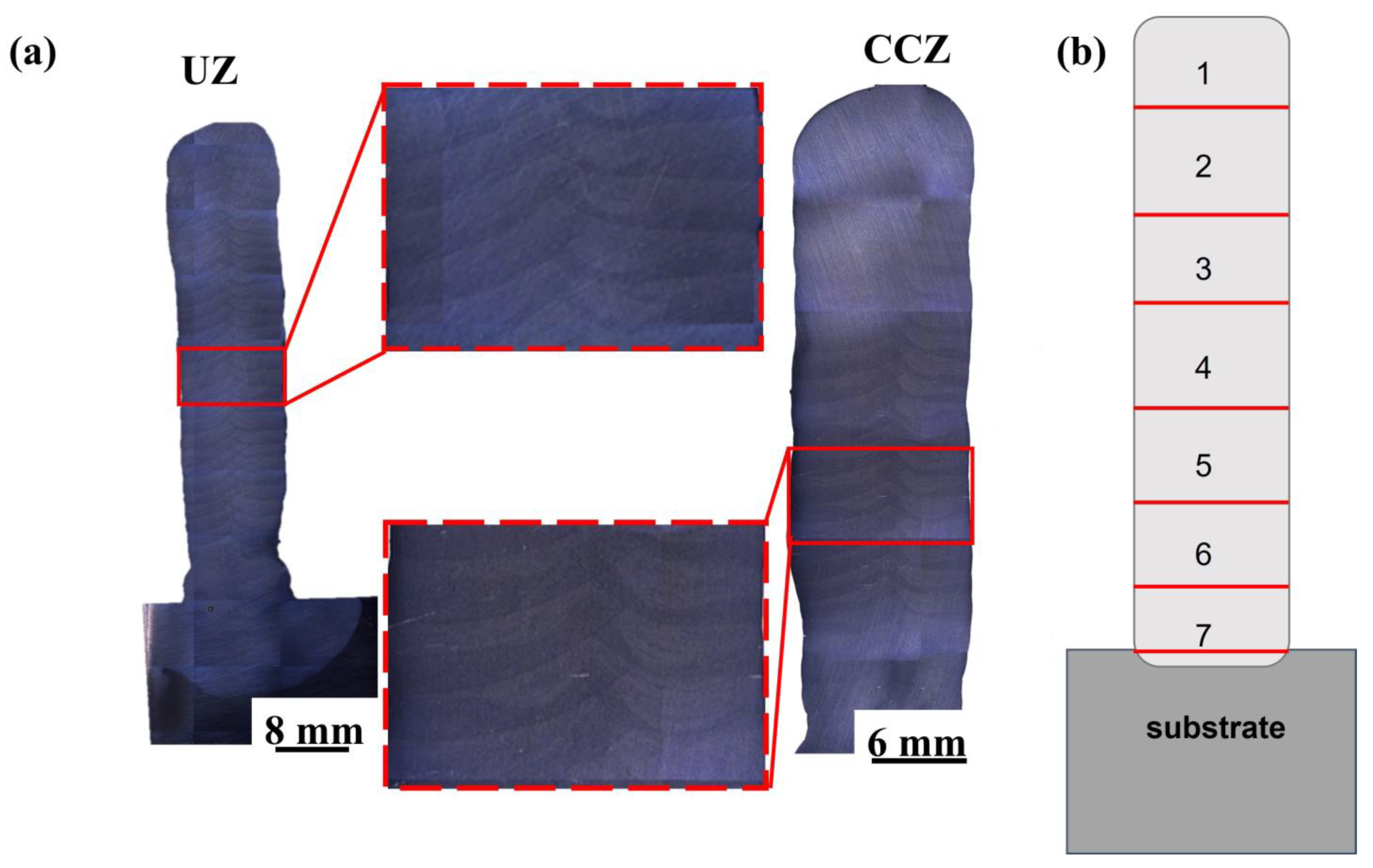

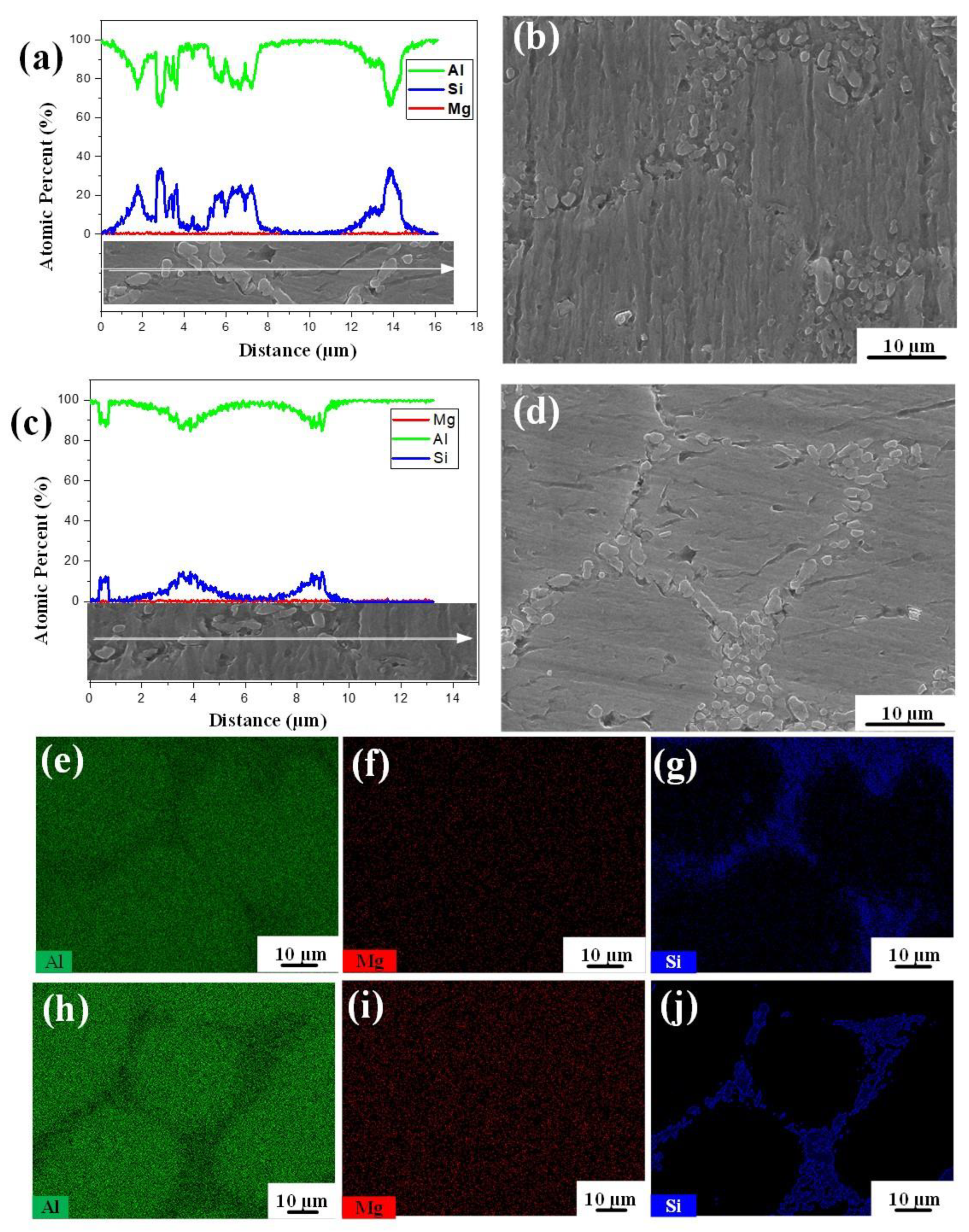
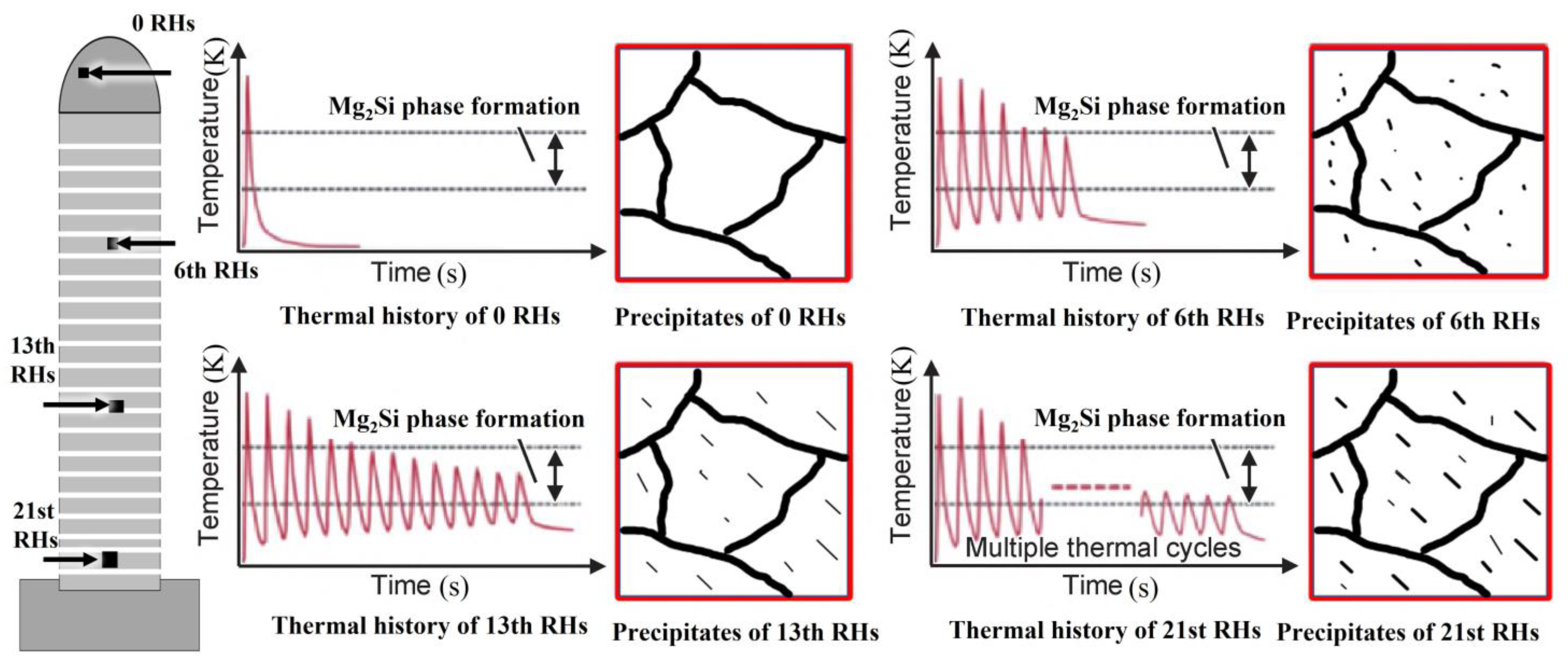
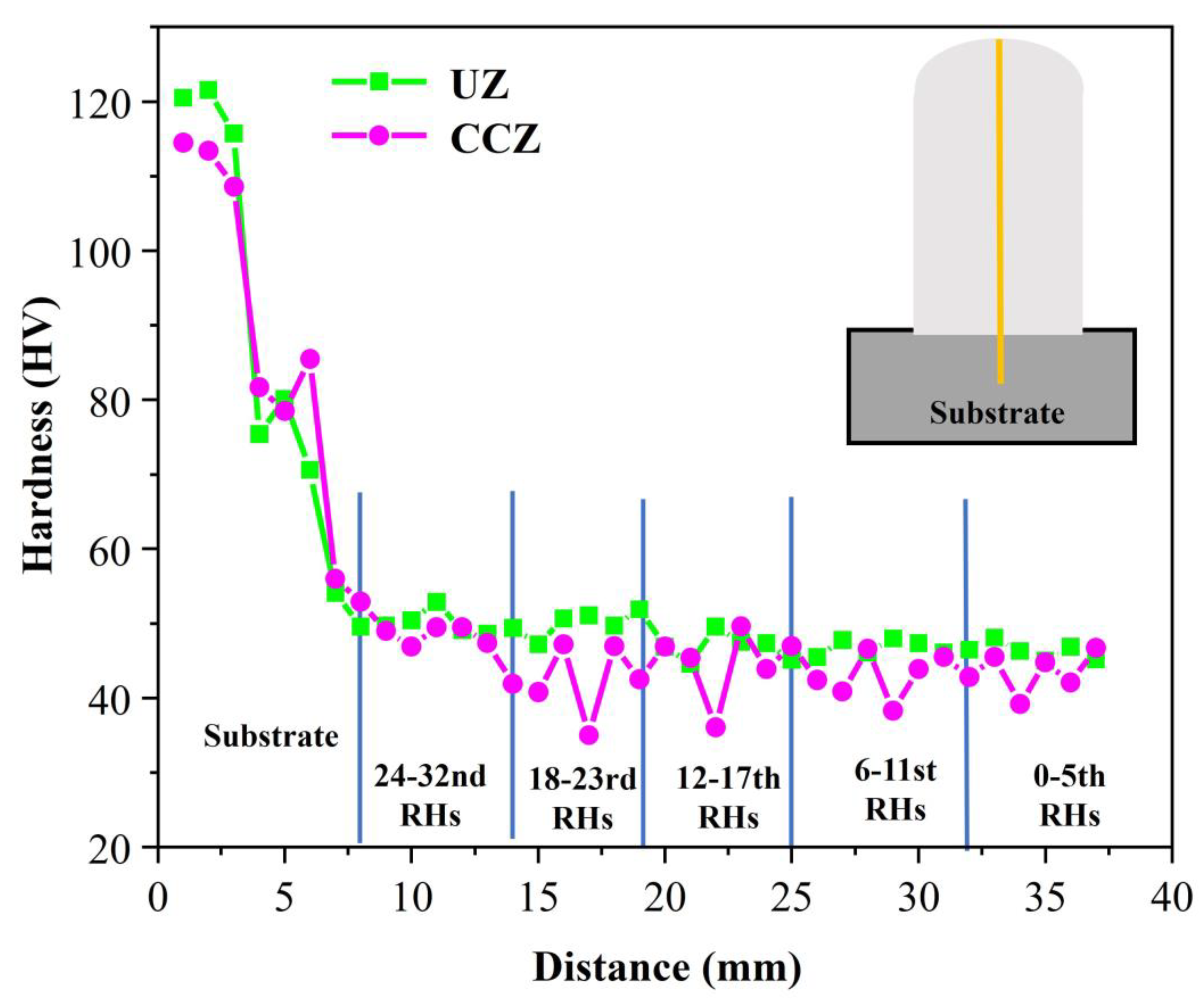
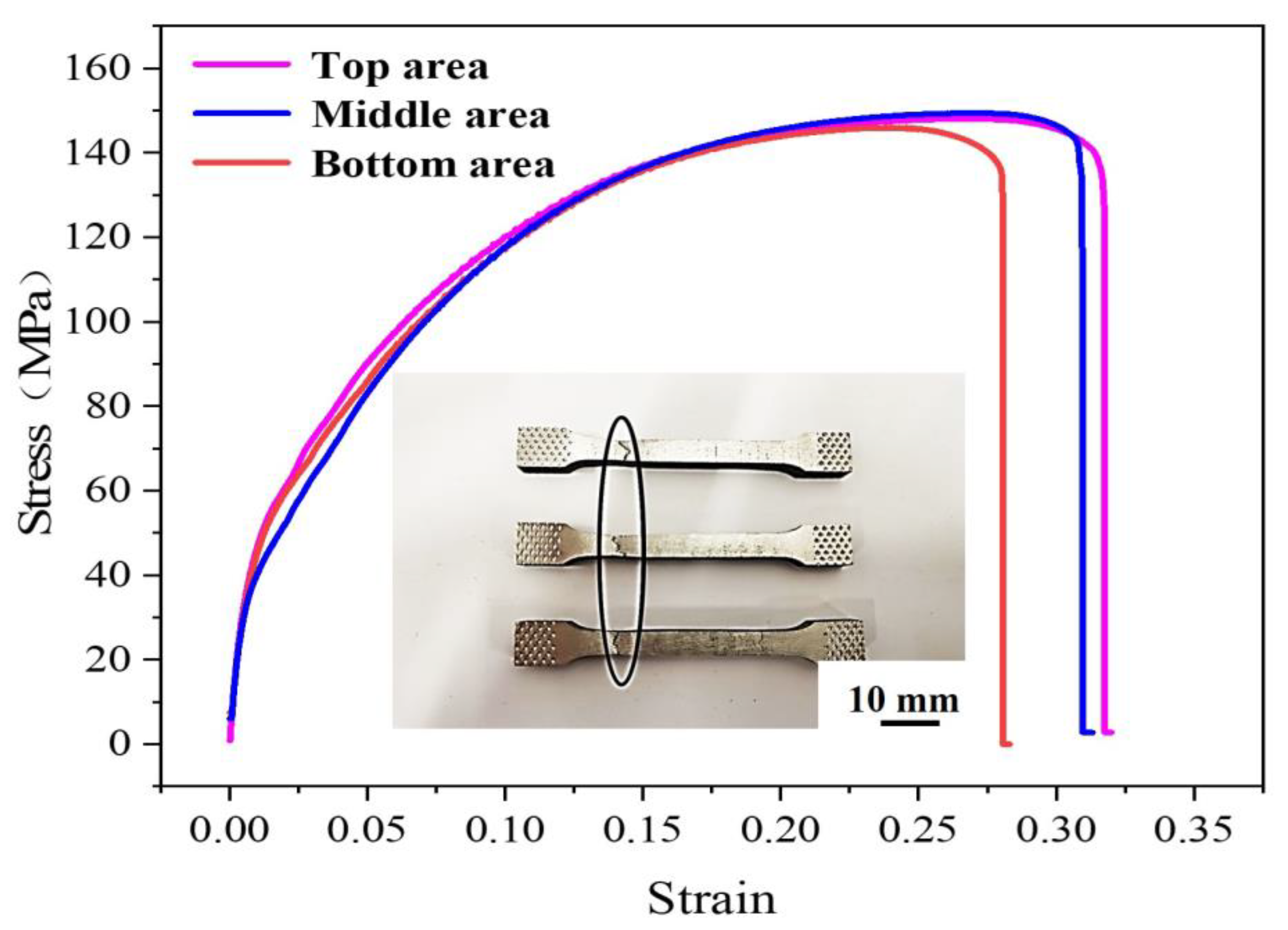
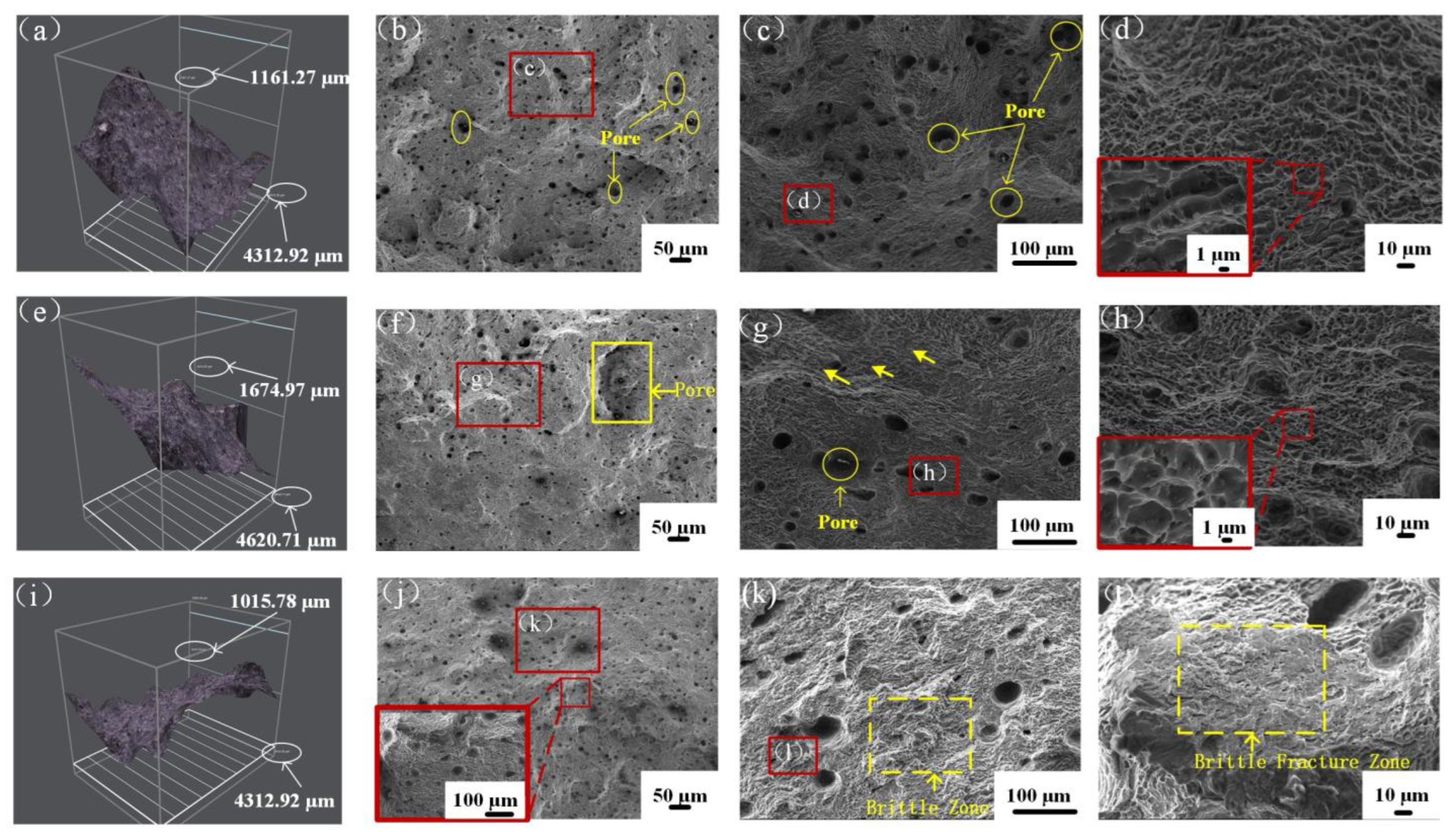
| Materials | Cu | Si | Fe | Mn | Mg | Zn | Cr | Ti | Al |
|---|---|---|---|---|---|---|---|---|---|
| 6061-T6 | 0.15–0.4 | 0.4–0.8 | ≤0.7 | ≤0.15 | 0.8–1.2 | 0.25–0.50 | 0.04–0.35 | ≤0.15 | Bal. |
| ER4043 | ≤0.05 | 5 | ≤0.04 | ≤0.05 | ≤0.10 | ≤0.10 | - | ≤0.20 | Bal. |
| Layers | Wire-Feeding Speed (m/min) | Traveling Speed (mm/s) | Arc Starting/ Welding current | Arc Stopping/ Welding Current | Arc Stopping Time (s) | Fade Time (s) | Wire Elongation Length (mm) | Actual Weld Width (mm) |
|---|---|---|---|---|---|---|---|---|
| 1 | 8 | 9 | 105% | 70% | 0.2 | 0.3 | 12 | 12.5 |
| 2 | 6 | 9 | 105% | 36% | 0.4 | 0.6 | 12 | 12.29 |
| 3–8 | 4.6 | 9 | 105% | 27% | 0.2 | 0.4 | 12 | 11.80 |
| 9–12 | 4.7 | 9 | 105% | 27% | 0.2 | 0.4 | 12 | 12.54 |
| 13–33 | 4.6 | 9 | 105% | 27% | 0 | 0.4 | 12 | 12.46 |
| Sample Location | Tensile Strength (MPa) | Elongation (%) |
|---|---|---|
| Top area | 149.4 ± 3.4 | 33.0 ± 1.9 |
| Middle area | 148.1 ± 3.0 | 32.0 ± 2.1 |
| Bottom area | 146.0 ± 4.9 | 28.3 ± 3.4 |
| GTAM [25] | 143.6 ± 2.9 | 19.6 ± 1.1 |
| Laser-arc hybrid AM [25] | 164.4 ± 4.8 | 20.8 ± 0.8 |
Publisher’s Note: MDPI stays neutral with regard to jurisdictional claims in published maps and institutional affiliations. |
© 2022 by the authors. Licensee MDPI, Basel, Switzerland. This article is an open access article distributed under the terms and conditions of the Creative Commons Attribution (CC BY) license (https://creativecommons.org/licenses/by/4.0/).
Share and Cite
Su, J.; Yang, Y.; Bi, Y.; Zhang, Y.; Bi, J.; Luo, Z. Effects of Corner Constraint on the Microstructure and Mechanical Properties of Aluminum Alloy Using the CMT+P Deposition Process. Metals 2022, 12, 1423. https://doi.org/10.3390/met12091423
Su J, Yang Y, Bi Y, Zhang Y, Bi J, Luo Z. Effects of Corner Constraint on the Microstructure and Mechanical Properties of Aluminum Alloy Using the CMT+P Deposition Process. Metals. 2022; 12(9):1423. https://doi.org/10.3390/met12091423
Chicago/Turabian StyleSu, Jie, Yue Yang, Yuanbo Bi, Yixuan Zhang, Jing Bi, and Zhen Luo. 2022. "Effects of Corner Constraint on the Microstructure and Mechanical Properties of Aluminum Alloy Using the CMT+P Deposition Process" Metals 12, no. 9: 1423. https://doi.org/10.3390/met12091423






